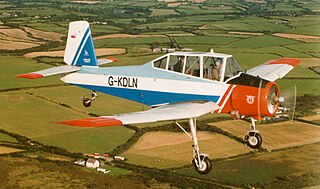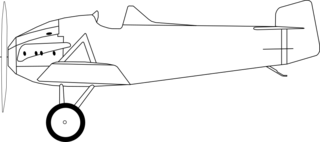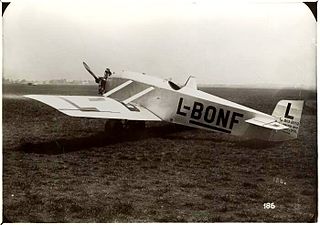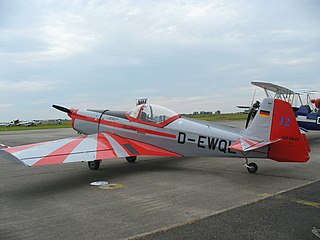
The Letov Š-18 was a Czechoslovak single-engined, two-seat biplane trainer. It was designed by Alois Smolík at Letov Kbely. The Š-18 first flew in 1925.

The Zlin Z-37 Čmelák, also known as LET Z-37 Čmelák is an agricultural aircraft which was manufactured in Czechoslovakia. It is powered by a Soviet-built Ivchenko reciprocating engine. The aircraft is used mainly as a cropduster.

The Avia BH-1 was a two-seat sports plane built in Czechoslovakia in 1920. It was the first product of the Avia company, and it was originally designated BH-1 exp. The BH-1 was a low-wing braced monoplane of wooden construction, with tailskid undercarriage. Power was provided by a Daimler engine, which proved inadequate to fly the aircraft with both seats occupied.

The Avia BH-4 was a prototype fighter aircraft built in Czechoslovakia in 1922. It was a development of the BH-3 fitted with a Hispano-Suiza 8 engine in an attempt to improve the aircraft's performance. To accommodate the new powerplant, the forward fuselage was considerably redesigned, and the structure in general and undercarriage in particular were strengthened. Performance was found to be only marginally better than the BH-3, and development was quickly abandoned.

The Avia BH-5 was a two-seat sport aircraft built in Czechoslovakia in 1923. It was based on the firm's experience with the BH-1 and shared that aircraft's basic design: a low-wing, braced monoplane. As a result of its L-BOSA registration, all slow flying Avia monoplanes of the BH-5 lineage were nicknamed Boska. The BH-5 was flown competitively by Zdeněk Lhota at the Belgian Touring Aircraft Contest in Brussels in 1923, and won both the overall prize for the event and the King of Belgium Prize. The same year, it won the first prize in its class in the Czechoslovak President of the Republic Competition.

The Avia BH-9 was a twin-seat sports plane built in Czechoslovakia in 1923, based on the BH-5. As with other developments in the BH-1 lineage, the BH-9 was a low-wing braced monoplane that accommodated the pilot and passenger in tandem, open cockpits. The BH-9's structure was strengthened to allow the use of a higher-power engine than in its predecessors, and for the first time, this was a domestically-produced powerplant. Although built as a twin-seat aircraft at least one was converted to a single-seater.

The Avia BH-10 was a single-seat aerobatic sports plane built in Czechoslovakia in 1924, based on the Avia BH-9, which was in turn developed from the BH-5 and BH-1. It was easily visually distinguished from the BH-9 by the tall anti-roll pylon added behind the open cockpit in order to protect the pilot in the event that the aircraft flipped over or crashed while inverted. 21 copies of the aircraft were built, 10 of which were bought by the Czechoslovakian Army as a training aircraft and operated under the designation B.10.

The Avia BH-11 was a two-seat monoplane sport aircraft designed and produced by the Czechoslovakian aircraft manufacturer Avia.

The Avia BH-16 was a single-seat very light sport aircraft built in Czechoslovakia in 1924. Like other early Avia designs, it was a low-wing braced monoplane of wooden construction. It could be powered by either a 12 kW (16 hp) four-cylinder Vaslin engine or a 19 kW (26 hp) inverted-V twin-Blackburne Tomtit.
The Avia BH-20 was a civil trainer aircraft built in Czechoslovakia in 1924. It was a single-bay, unstaggered biplane of conventional configuration. The wings were braced with N-struts at around half-span. The pilot and instructor were seated in tandem, open cockpits.

The Avia BH-26 was a two-seat armed reconnaissance aircraft built in Czechoslovakia in 1927. It was a single-bay unstaggered biplane with equal-span wings and a fixed tailskid undercarriage. Both upper and lower wings featured long-span ailerons, which were dynamically balanced by a small auxiliary airfoil mounted to the upper surface of the lower ailerons. Its design was typical of this type of aircraft built during World War I and the years following; pilot and observer sat in tandem open cockpits with the observer armed with a machine gun on a ring mount. As with many other Avia designs, the BH-26 originally had no fixed fin, only a rudder, but this was changed in service.

The Avia BH-28 was a military reconnaissance biplane aircraft developed in Czechoslovakia in 1927 to meet a requirement for such an aircraft by the government of Romania. Avia based the design on their BH-26, but replaced the engine with an Armstrong Siddeley Jaguar, as specified in the requirement. The completed aircraft was taken to Bucharest for demonstration, but no order ensued, and this prototype was the only example constructed.

The Avia BH-33 was a biplane fighter aircraft built in Czechoslovakia in 1927. It was based on the BH-21J which demonstrated promising results by combining the original BH-21 airframe with a licence-built Bristol Jupiter radial engine. Other than the peculiar Avia hallmark of having an upper wing with a shorter span than the lower, it was utterly conventional, even featuring a tail fin for the first time in a Pavel Beneš and Miroslav Hajn design.

The Praga BH-111 was a sportsplane of Czechoslovakia, designed and built specifically to compete in Challenge 1932, the European touring plane championships. It was a two-seater low-wing monoplane.

The Zlin Z-526 Akrobat is a Czech sports plane used in aerobatics.

The International F-17 Sportsman was a 1920s American three-seat open-cockpit biplane designed and manufactured by the International Aircraft Corporation in Long Beach, California and Cincinnati, Ohio. 107 aircraft were built, 77 of them at Cincinnati.

The Focke-Wulf A 20 Habicht was an airliner developed in Germany in the late 1920s. It was a high-wing cantilever monoplane with fixed tailskid undercarriage. The fuselage was deep and seated four passengers in a fully enclosed cabin. The type was not bought by the airlines and only a few examples were built.

The PWS-51 was a Polish sports plane of 1930, a single-engine low-wing monoplane, constructed by the Podlaska Wytwórnia Samolotów (PWS), that remained a prototype.

The IMAM Ro.5 was a sport aircraft designed by Alessandro Tonini and produced by IMAM in Italy in the late 1920s.

The Boeing Model 6D, a.k.a. Boeing Model 6E, Boeing B-1D and Boeing B-1E, was an American pusher biplane flying-boat built by Boeing between 1928 and 1929.




















